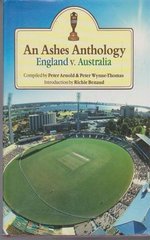An Ashes Anthology
David Taylor |Published: 1989
Pages: 246
Author: Wynne-Thomas, Peter and Arnold, Peter (Editors)
Publisher: Christopher Helm
Rating: 3 stars

With the resumption, all too soon to many English supporters, of one of sport’s oldest rivalries it seemed a good idea to dig this one and have another look at it. We have covered ‘the Ashes in print’ before of course, three years ago to be precise, but this is one book that takes in every series from 1882-83, when Ivo Bligh and his men were presented with that curious trophy, to 1986-87 and the success of Mike Gatting’s famously under-estimated crew. The names of the two compilers are only vaguely familiar, but they got Richie Benaud to provide a preface, or ‘prologue’ as they call it for some reason, in which he describes his earliest memories of Ashes contests and a few that he took part in, and while there is little that would be unknown to anyone who has read one of his books, it makes for an engaging three pages.
There follows an introduction, written presumably by one or both of the compilers, which mentions the contests between 1876-77 and 1882, and then we’re into the body of the book. It’s divided, logically but perhaps unnecessarily, into three sections, split by the two World Wars. Australia in January 1883 is where we begin.
There follows an entry for each series, a short introduction followed by a contemporary newspaper report or extract from a book on the series. Those who have several Ashes books will probably find some familiar ground, but the majority of matches are represented by news reports, and it’s fascinating to see how language has changed over a hundred years. From the Melbourne Argus, reviewing Bligh’s match, comes a lot of obsequious fluff about Bligh’s family, the Earls of Darnley, two thousand words or more without even the small comfort of a new paragraph now and again. Only at the very beginning of the piece does the (unnamed) writer mention the match, in which he states –
“there is not a shadow of a doubt that the team which was most fit for the contest won. The English Eleven has worked into brilliant form. It is no exaggeration to say that such fielding as they exhibited has never been seen on an Australian ground before, and the bowling was of the first class also”
One hundred and thirty years on, it’s hard to imagine the likes of Malcolm Conn being quite so gracious.
Some of the selections are magazine articles concentrating on a single player; for 1903-04 comes a piece by WA Bettesworth in the magazine ‘Cricket’ predicting a bright future for RE Foster. In 1965-66 Ian Wooldridge wrote about Doug Walters – ‘the Dungog Dasher’ – who had just made a hundred on debut. It’s a pity that this perceptive piece is illustrated by a picture of Ian Redpath batting. Most, but not all, of the chapters have a single black and white illustration.
By its nature this probably isn’t a book that needs to be read from end to end, and as I have already suggested the writing is not by any means all of a high quality, but it is a diverting ‘dip-in’ with which to amuse oneself while awaiting the resumption of hostilities.






Leave a comment